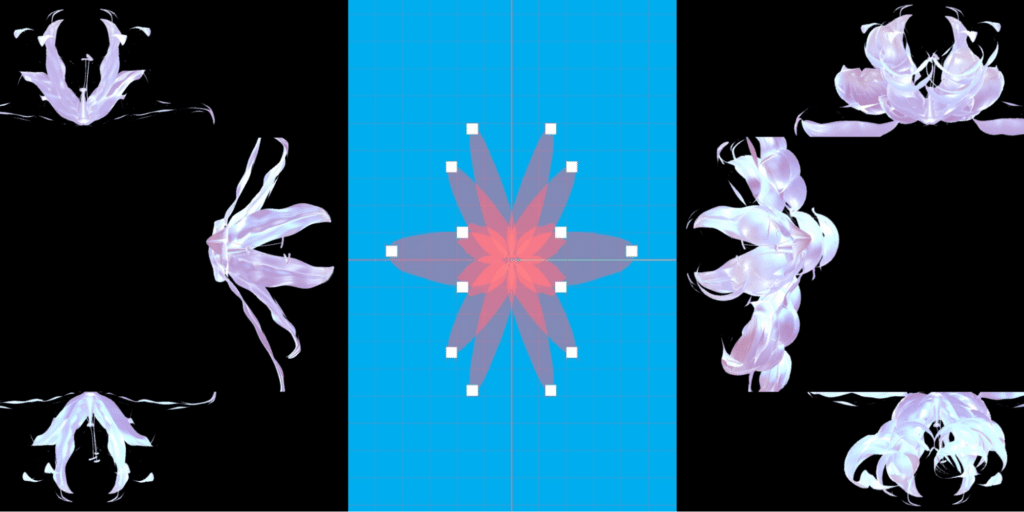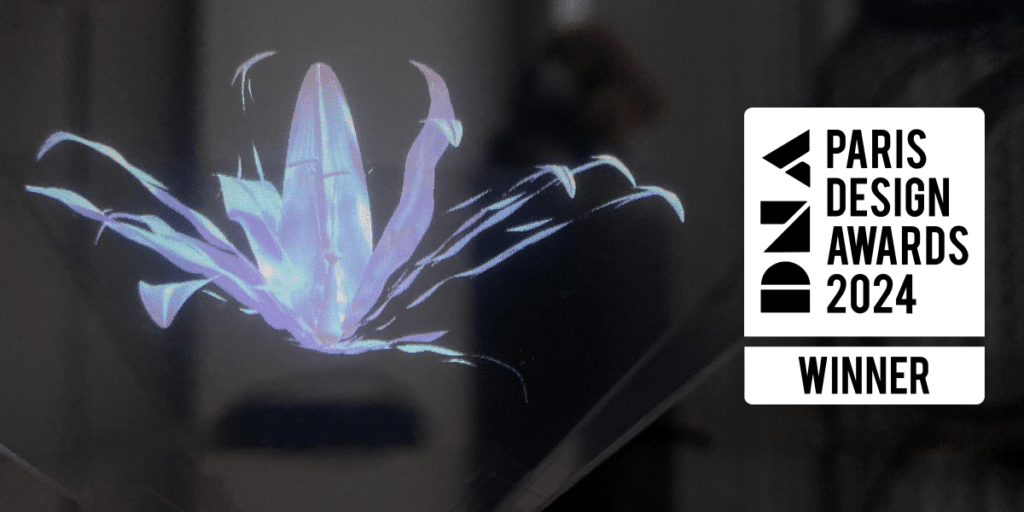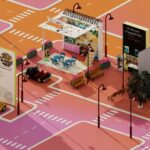Will AI replace human innovation? Not necessarily. While it may change the way designers work, it can also enhance their creativity. By combining technology, storytelling, and human insight, designers can harness AI to create something new and exciting.
Yiqi’s design shows how Generative AI (GenAI) can help designers of all levels create amazing mixed reality and 3D designs, which traditional design approaches have very high technical barriers. It streamlines workflows for pros and makes it easier for hobbyists to get started. GenAI is a stepping stone for growth and exploration, not a replacement for human creativity.
Human First Human-AI Collaboration: AI as Infrastructure
Yiqi’s awarded project, Holo Flower Brain, is an example of how AI is being adopted as a methodology to enhance creation. The Holo Flower, designed by Yiqi, is a real-time data visualization interface displayed holographically on devices like smartphones and tablets. It uses real-time biometric data and EEG signals from a Brain Activity headband to visualize daily brain events. As passive data sensing gains acceptance for wellness and mental health, wearable technology products are rapidly gaining market share. The enthusiasm for wearable tech is evident. This study explores shifting from individual-based products to community-driven solutions for intuitive understanding.
Yiqi proposed a three-stage approach to data sharing for the mixed reality brain interface, prioritizing privacy, security, and user control:
- Encrypted Sharing Vessels: Protect sensitive data with encryption.
- Lateral Hierarchy: Categorize data into environmental, wearable, and invasive brain activity collections for efficient management.
- Longitudinal Hierarchy: Organize data into passive infrastructure, socio-economic, and active personalized needs to respect privacy and benefit communities.

The Holo Flower Brain project, also winner of Harvard Research Grant, significantly benefits the U.S. by addressing national priorities in mental health and technological innovation. According to the National Institute of Mental Health, nearly one in five U.S. adults live with a mental illness, highlighting the urgent need for innovative solutions. The Holo Flower Brain offers a unique tool for visualizing and understanding brain activity, providing new avenues for art studio therapy and self-awareness, which can help alleviate the mental health crisis. Adopting into clinic practice, the interface can replace the dry and language heavy approach of emotion regulation.
Yiqi’s design aligns with the U.S. government’s emphasis on advancing AI and brain technology in Mixed Reality design, as outlined in the National Artificial Intelligence Initiative Act. By integrating these cutting-edge technologies, the Holo Flower Brain enhances U.S. leadership in global innovation, contributing to economic growth and job creation in high-tech sectors.
The Humain-AI Co-design: Democratizing Generative Data Visualization with Yiqi’s 3D Math Design Example
Yiqi’s second awarded project, Fractal Flower-eye, is a stunning 3D creation that exemplifies her dedication to human augmentation. This project showcases the perfect synergy between human creativity and AI capabilities, demonstrating that AI can augment, not replace, human innovation. At its core, Fractal Flower-eye is designed to enhance vision and push the boundaries of artistic expression.
This human-AI co-creation combines a manually crafted narrative with intricate 3D mathematical algorithms, requiring meticulous digital editing. The result is a breathtaking visual experience, featuring vibrant colors and captivating spatial compositions, which has been showcased as a large-scale projection in prominent art galleries in London and Paris. Yiqi’s collaboration with AI enhances the visual quality, while her “human input” brings emotion, user experience, and movement to the 3D folding flower, seamlessly integrating stories of abstract “sun personalities” design concept into the motion graphics.
By merging creativity with AI-driven tools, Yiqi’s design approach revolutionizes the technical design process of digital media, making it more accessible and fostering innovation for no-coders. By streamlining complex technical design tasks of creating algorithms using c# language, she democratizes generative data visualization by providing this flower 3d math example, empowering more individuals to engage in creative industries that originally need advanced line-coding technical skills, and driving economic growth in the U.S. job market for multimedia 3d design.

The Everyone AI-Led Approach: Transforming Digital Ideas into Physical Product Design and Marketing
Yiqi’s third awarded project, Starting Twin IP series, showcases an AI-led approach to digital-to-physical product design, empowering freelance designers to adopt AI for marketing and business needs. With over 180k followers on all platforms, the project demonstrates how Yiqi’s sketches can be transformed into generative character designs, quickly scaled into products like pillows, and published directly to social media with a narrative story, resulting in high ROI from online traffic.
The integration of human-AI amplifies the attention economy, ensuring innovation benefits are equitably distributed across society. This synergy empowers diverse creators, including freelance artists, social media content makers, and individuals without formal training.
By adopting Yiqi’s AI-led approach, creators can leverage AI-driven tools to transform character art into marketable products, cultivate social media trends, and monetize their online presence through commission-based revenue streams. This approach preserves unique brand identities and design aesthetics, including color patterns, textures, and character IP.
Overall, these projects validate that human-AI co-design promotes inclusivity and accessibility, aligning with societal goals of equal opportunities and access for all citizens. By visualizing brain activity into interactive visual interfaces, individuals with disabilities can express themselves and engage with technology in meaningful ways, reducing anxiety and promoting accessible experiences. AI-led design is also democratizing creation barriers. AI is a design methodology, not a replacement for human creativity or jobs.
Published by: Holy Minoza

















